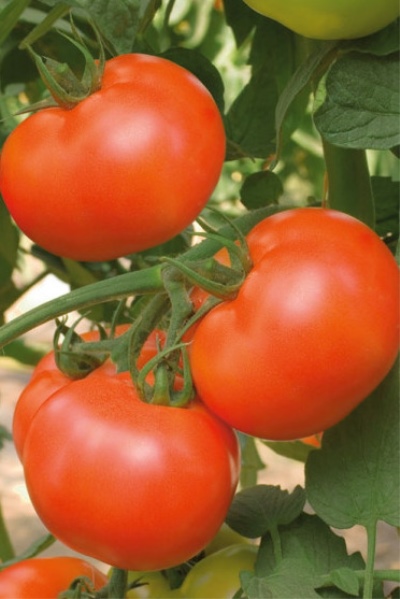
- Authors: Avdeev Yu. I., Kigashpaeva O. P., Ivanova L. M., Shcherbinin B. M. FSBSI 'All-Russian Research Institute of Irrigated Vegetable and Melon Growing'
- Year of approval: 1997
- Category: grade
- Growth type: indeterminate
- Appointment: universal
- Ripening period: mid-season
- Ripening time, days: 115-122
- Growing conditions: for open ground
- Marketability: high
- Transportability: Yes
An excellent gift for gardeners from breeders can be safely considered the indeterminate variety of Astrakhan tomato for universal purposes. Its fruits are large, decorative and versatile. The variety is intended for open field cultivation in a seedless way, but this applies to regions with a warm climate. The fruits are used both fresh and for preservation - juices, sauces, winter salads.
Breeding history
The cultivation of an amazing variety is due to the work of eminent breeders:
Yu. A. Avdeev;
L. M. Ivanova;
B. M. Shcherbinin;
O. P. Kigashpaeva.
The variety was approved for cultivation in 1997.
Description of the variety
The indeterminate variety gives medium-sized compact bushes of medium branching with a height of 65-80 cm. Grown in the designated territories, this tomato variety does not need shelter, has both positive and negative characteristics.
Advantages | disadvantages |
Unpretentious care | Designed only for cultivation in the southern regions |
Gives high yields | Skin too tight |
Has strong immunity | |
Has a shallow root system, which facilitates autumn cleaning of the planting area | |
Produces excellent fruit outdoors |
Shoots are covered with dark green, moderately dissected, slightly corrugated leaves. The plant lays intermediate inflorescences - the first is laid over 7-8 leaves
The main qualities of the fruit
Unripe large rounded fruits have a milky green color; at the time of technical ripeness, tomatoes are colored bright red. The weight of an individual fruit is 102-106 g, all of them are covered with a dense glossy skin, which determines good keeping rates and transportation.
Taste characteristics
The firm pulp of tomato has a very pleasant, soft and slightly creamy, moderately sweet taste. Fruits contain 4.5-4.7% dry matter, acidity 0.38-0.45%, sugar index 2.3-2.6%.
Ripening and fruiting
Astrakhan tomato belongs to mid-season varieties with extended fruiting - ripening period 115-122 days. Ripe tomatoes are harvested in September.
Yield
Tomato is famous for its high yields - up to 4 kilograms of tomatoes are harvested from one bush, 516-724 quintals per hectare. The difference depends on the fulfillment of agrotechnical requirements.
The timing of planting seedlings and planting in the ground
Where the seedling method is used, the seeds are sown from February to April. It all depends on the timing of planting in the ground: 60–65 days from the day of germination. They are planted in a permanent place when the ground is sufficiently warmed up and provided that there are no return frosts.

Growing tomato seedlings is an extremely important process, because it largely depends on whether the gardener can harvest at all. All aspects must be taken into account, from seedbed preparation to planting in the ground.
Landing scheme
When planting seedlings in a permanent place, the root arrangement is observed: 70x40 cm.

Growing and care
The cultivation of the Astrakhansky variety corresponds to the agrotechnical standards and techniques generally accepted for tomatoes. The plant will need growth restriction - the pinching of the growth point is carried out when the upper border of the greenhouse is reached, or to redirect the forces towards ripening the fruits. For planting, choose a well-lit place with such previous crops as onions, melons (cucumbers, watermelons, melons, zucchini, squash). Experts categorically do not recommend planting tomatoes after nightshades (peppers, eggplants, potatoes, physalis), explaining that crops are prone to the same diseases.
During the preparation of planting holes, the soil is enriched with mineral fertilizers and organic matter (manure, compost, humus). At the same time, a support is installed in the hole, otherwise the stems may not withstand and lie down or break. After planting the plants in the hole, the ground is tamped and well moistened with settled warm water. All subsequent activities consist in pinching, breaking off the lower leaves while pouring fruits, watering, feeding, loosening, hilling.
Additional nutrition is applied approximately once every two to three weeks - during flowering with nitrogen fertilizers, during the period of filling with potassium-phosphorus fertilizers, organic matter is introduced in the fall. The bushes form 1-2 stems, removing stepchildren and lateral shoots, sometimes you have to tie up not only the stem, but also brushes with heavy fruits.




A plant needs different micronutrients at each stage of growth. All fertilizers can be divided into two groups: mineral and organic. Folk remedies are often used: iodine, yeast, bird droppings, eggshells.
It is important to observe the rate and period of feeding. This also applies to folk remedies and organic fertilizers.
Disease and pest resistance
Astrakhan has strong immunity, excellent resistance to diseases such as:
cracking;
top rot;
tobacco mosaic virus and others.
In addition to these diseases, the plant can be threatened by the larvae of beetles and the beetles themselves - now tomatoes are actively attacked by the Colorado potato beetle. Given these factors, it is necessary to carry out preventive treatments with insecticides and fungicides.


Resistant to adverse weather conditions
The variety copes well with the dry season.
Growing regions
Astrakhan tomato is adapted for growing outdoors in the Lower Volga and North Caucasian regions. In temperate climates, the tomato has to be grown in seedlings.

























































































